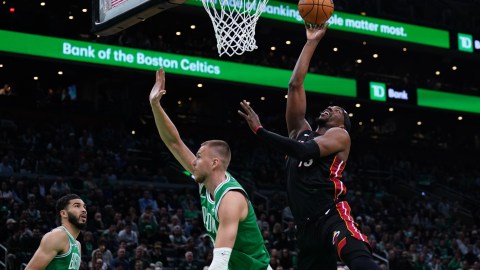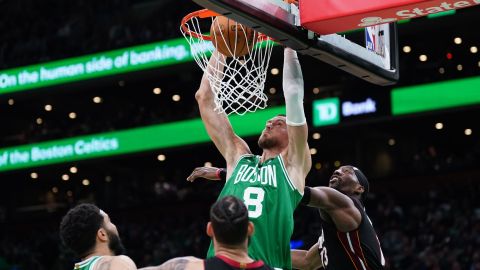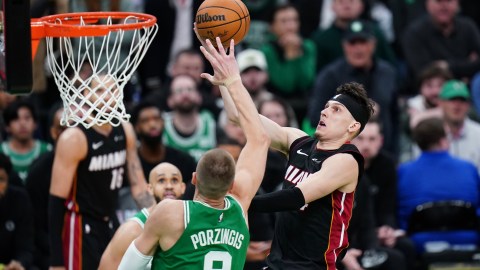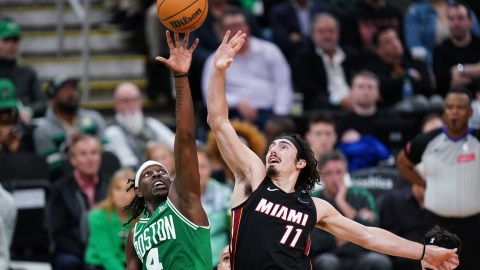When LeBron James proclaimed that he was taking his talents to South Beach to form his own “Big Three” with Dwyane Wade and Chris Bosh, the New York Knicks had a problem on their hands. Of the 2010 free-agent class, Amare Stoudemire already had signed on to wear the orange and blue, but the Knicks needed that other piece to help put the once-proud franchise back in title contention.
That piece was now nowhere to be found, and now with the team off to another poor start, the Knicks look foolish once again by making too many shortsighted moves. If only Knicks president Donnie Walsh could have looked north on I-95 toward Boston, he may have been able to prevent this new Knicks disaster from happening
It was three seasons ago that Celtics fans found themselves in the same place that Knicks fans find themselves today. Instead of hoping for the prize free agent to choose them, Celtics fans were hoping for a good draft position. The 2007 draft class featured potential studs in Greg Oden and Kevin Durant. By finishing 24-58 that season, the Celtics had the second-best odds of landing the top pick in the draft. Fans hoped that by getting either Oden or Durant, Paul Pierce would back off his trade request. The Ping-Pong balls gave Boston the fifth pick.
Celtics general manager Danny Ainge had a bold plan in place though. By working the trade market and drafting a solid nucleus in the previous few drafts, Ainge had three things every GM loves to have at their disposal: young talent, expiring contracts and a surplus of future draft choices. Ainge was able to turn the fifth pick (Jeff Green) along with Delonte West, Wally Szczerbiak and a future second-round pick into Ray Allen and the draft choice that was Glen “Big Baby” Davis. One month later, Kevin Garnett became a Celtic in a blockbuster trade that required a young talent in Al Jefferson, a huge contract in Theo Ratliff and two future first-round picks. Pierce rescinded his trade request.
What Ainge did was nothing short of brilliant. He was able to use the strengths the franchise had, not much of which involved substantial basketball talent, and turn it into a former MVP and one of the best pure shooters in NBA history. With the continuing development of 2006 first-round pick Rajon Rondo and center Kendrick Perkins and a couple of bargain free agents such as James Posey and Eddie House, Boston was able to fire up the duck boats and celebrate its record 17th NBA championship.
Donnie Walsh did not have the same vision as Danny Ainge, and neither did Walsh’s predecessor, Isiah Thomas. Whereas Ainge built through the draft by drafting or acquiring Perkins, Jefferson and Rondo on draft nigh, the Knicks mismanaged their draft picks.
In 2006, the Knicks held the 20th pick of the draft, and Thomas made a surprise pick in forward Renaldo Balkman. Thomas also took Mardy Collins with the 29th pick to back up the eccentric Stephon Marbury at point guard. Neither player has scored a point so far this season.
Ainge, on the other hand, worked out a draft-day trade with the Phoenix Suns for the 21st pick. Rajon Rondo was his choice.
In addition, Thomas hurt the Knicks by trading away future draft choices for lackluster talent. In order to acquire Eddy Curry, the Knicks, just as the Celtics did in the Garnett trade, sent two first-round draft picks for the gargantuan center. Those two picks turned into LaMarcus Aldridge and Joakim Noah. Curry played 62 total minutes last year, and has yet to see game action this season.
It is no wonder why any mention of Isiah Thomas to Knicks fans makes them curl up into a ball.
While the Knicks have found some success in the draft by taking David Lee and Danilo Gallinari, among others, much of the talent was traded away to make room for the man who never showed, LeBron James. Walsh sent Nate Robinson to the Celtics for Eddie House to create cap space (another trade where Ainge emerged victorious), along with sending rookie lottery pick Jordan Hill to the Houston Rockets for Tracy McGrady.
Rick Pitino made a similar move a decade earlier when he was in charge of the Celtics by trading rookie lottery pick Chauncey Billups to the Toronto Raptors for Kenny Anderson. As fans prefer not to remember the Rick Pitino era in Boston, Knicks fan may not want to remember the Donnie Walsh era if Hill turns into a stud and marquee talent continues to avoid the Big Apple.
Danny Ainge went the direct route in trading young talent for players still in their prime. He built through the draft and acquired enough assets that could bring in even bigger names and brought Boston a title.
Walsh took the long way, by trading young talent for old and nonexistent talent, in the hopes of somehow still luring premiere talent. Walsh is currently at the gas station asking for directions on how to get back to title town.
Nathaniel Lowenthal is a member of NESN’s production team.



